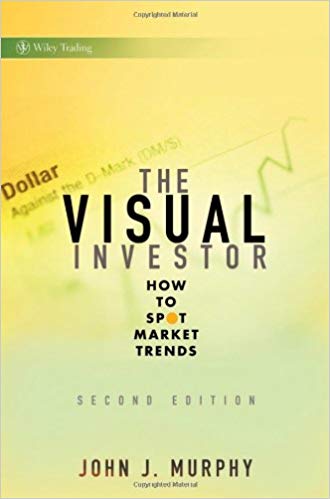
جان مورفی نامی آشنا در حوزه تحلیل تکنیکال در بازار سرمایه است. یکی از جدیدترین کتاب های وی کتابی است با عنوان:
SECTION ONE: INTRODUCTION.
What Has Changed?
Fund Categories.
Global Funds.
Investors Need to Be Better Informed.
Benefits of Visual Investing.
Structure of the Book.
CHAPTER 1: What Is Visual Investing?
Why Market Analysis?
The Trend Is to Blend.
What's in a Name?
Why Study the Market?
Chartists Are Cheaters.
It's Always Just Supply and Demand.
Charts Are Just Faster.
Charts Do Look Ahead.
Pictures Don't Lie.
Picture Anything You Want.
The Market's Always Right.
It's All About Trend.
Isn't the Past Always Prologue?
Timing Is Everything.
Summary.
CHAPTER 2. The Trend Is Your Friend.
What Is a Trend?
Support and Resistance Levels.
Role Reversal.
Short Versus Long Term.
Daily, Weekly, and Monthly Charts.
Recent versus Distant Past.
Trendlines.
Channel Lines.
Retracing Our Steps by One-Third, One-Half, and Two-Thirds.
Weekly Reversals.
Summary.
CHAPTER 3: Pictures That Tell a Story.
Chart Types.
Time Choices.
Scaling.
Volume Analysis.
Chart Patterns.
Measuring Techniques.
Even the Fed Is Charting.
The Triangle.
Points and Figure Charts.
Chart Pattern Recognition Software.
SECTION TWO: INDICATORS.
CHAPTER 4 Your Best Friend in a Trend.
Two Classes of Indicators.
The Moving Average.
The Simple Average.
Weighting the Average or Smoothing It?
Moving Average Lengths.
Moving Average Combinations.
Summary.
CHAPTER 5: Is It Overbought or Oversold?
Measuring Overbought and Oversold Conditions.
Divergences.
Momentum.
Welles Wilde's Relative Strength Index.
The Stochastics Oscillator.
Combine RSI and Stochastics.
Summary.
CHAPTER 6: How to Have the Best of Both Worlds.
MACD Construction.
MACD as Trend-Following Indicator.
MACD as an Oscillator.
MACD Divergences.
How to Blend Daily and Weekly Signals.
How to Make MACD Even Better—The Histogram.
Be Sure to Watch Monthly Signals.
How to Know Which Indicators to Use.
The Average Directional Movement (ADX) Line.
Summary.
SECTION THREE: Linkage.
CHAPTER 7 Market Linkages.
The Asset Allocation Process.
The Relative Strength Ratio.
2002 Shift from Paper to Hard Assets.
Commodity/Bond Ratio also Turned up.
Turns in the Bond/Stock Ratio.
2007 Ratio Shifts Back to Bonds.
Bonds Rise as Stocks Fall.
Falling U.S. Rates Hurt the Dollar.
Falling Dollar Pushes Gold to Record High.
Commodity-Related Stocks.
Foreign Stocks Are Linked to the Dollar.
Commodity Exporters Get Bigger Boost.
Global Decoupling Is a Myth.
Rising Yen Threatens Global Stocks.
Review of 2004 Intermarket Book.
Summary.
CHAPTER 8: Market Breadth.
Measuring Market Breadth with NYSE AD Line.
NYSE AD Line Violates Moving Average Lines.
Advance-Decline Shows Negative Divergence.
Where the Negative Divergences Were Located.
Retail Stocks Start to Underperform During 2007.
Retailers and Homebuilders Were Linked.
Consumers are also Squeezed by Rising Oil.
Dow Theory.
Transports Don't Confirm Industrial High.
Percent of NYSE Stocks above 200-Day Average.
NYSE Bullish Percent Index.
Point-and-Figure Version of BPI.
Summary.
CHAPTER 9: Relative Strength and Rotation.
Uses of Relative Strength.
Top-Down Analysis.
Relative Strength versus Absolute Performance.
Using Relative Strength between Stocks.
Comparing Gold Stocks to Gold.
How to Spot New Market Leaders.
Where the Money Came from.
Spotting Rotation Back into Large Caps.
Trend Changes Are Easy to Spot.
Rotation within Market Sectors.
Chinese Stocks Lose Leadership Role.
Summary.
SECTION FOUR: MUTUAL FUNDS AND EXCHANGE TRADED FUNDS.
CHAPTER 10 Sectors and Industry Groups.
Difference between Sectors and Industry Groups.
Performance Charts.
Sector Carpets.
Using Market Carpet to Find Stock Leaders.
Industry Group Leader.
Sector Trends Need to Be Monitored.
Information on Sectors and Industry Groups.
Spotting Natural Gas Leadership.
Natural Gas Components.
CBOE Volatility (VIX) Index.
Summary.
CHAPTER 11: Mutual Funds.
What Works on Mutual Funds.
Open–versus Closed-End Funds.
Charting Adjustments on Open-End Funds.
Blending Fundamental and Technical Data.
Relative Strength Analysis.
Traditional and Nontraditional Mutual Funds.
Keep It Simple.
200-Day Moving Average and Housing.
Natural Gas Breakout.
Consumer Discretionary Breakdown.
Bear Crossing Sinks Chips.
Negative ROC Hurts Technology.
Consumer Staples Hold Up Okay.
Retail Ratio Plunges.
Energizing a Portfolio.
Latin America Leads.
Real Estate Is Global.
Profunds Rising Rates Fund.
Profund Falling U.S. Dollar Fund.
Commodity Mutual Funds.
Inverse Stock Funds.
Summary.
CHAPTER 12: Exchange-Traded Funds.
ETFs versus Mutual Funds.
Using ETFs to Hedge.
Using a Bear ETF.
Trading the Nasdaq 100.
Using Sector ETFs.
Inverse Sector ETFs.
Using Technology as a Market Indicator.
Commodity ETFs.
Foreign Currency ETFs.
Bond ETFs.
International ETFs.
Summary.
Conclusion.
Why It's Called Visual Investing.
The Media Will Always Tell You Why Later.
Media Views Keep Shifting.
Visual Analysis Is More User Friendly.
Keep It Simple.
Visual Tools Are Universal.
The Stock Market Leads the Economy.
Prices Lead the Fundamentals.
Sector Investing.
Exchange-Traded Funds.
A Year After the 2007 Top.
Warning Signs were Clearly Visible.
APPENDIX A: Getting Started.
Find a Good Web Site.
Use the Readers Choice Awards.
StockCharts.com.
ChartSchool.
Online Bookstore.
Investor's Business Daily.
Stock Scans.
Bullish Percent Indexes.
DecisionPoint.com.
McClellan Breadth Indicators.
APPENDIX B: Japanese Candlesticks.
Candlestick Patterns.
Bullish Engulfing Pattern.
Stock Scan Candlestick Patterns.
Recommended Reading.
APPENDIX C: Point-and-Figure Charting.
Triple and Quadruple Signals.
How to Vary P&F Charts for Sensitivity.
There's No Doubt about P&F Signals.
Recommended Reading.
Index.
دیدگاه خود را ثبت کنید